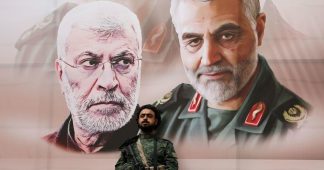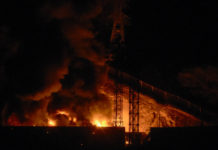By
It was the end of an otherwise unremarkable Thursday in January for service members stationed at the U.S. complex at Baghdad International Airport. But just minutes after midnight, Hellfire missiles broke the quiet as they rained down on a far corner of the sprawling site known as BIAP.
“It was like, ‘oh s— we got struck,'” an active member of the U.S. armed forces who was stationed at the airport told Newsweek. The member’s named is being withheld because they are not authorized to speak publicly about the incident.
Iraqi personnel also scrambled in response to the shocking, mysterious strike on “one of the safest roads we have here in the capital,” as one Iraqi official described it to Newsweek. But not far from where both military and civilian flights had been operating as usual, two vehicles were left smoldering on a road along the eastern stretch of the airport.
“It was surreal,” the Iraqi official, who was not authorized to speak with the media, later told Newsweek.
Both U.S. and Iraqi personnel on-site considered the strike to be yet another episode of rogue rocket fire by local Katyusha-wielding militias that are opposed to the Pentagon’s prolonged presence in the country. But the strike would set Washington and Tehran on a course like no other in their four-decade feud.
“We had to take our posture and then, we’re watching Al Jazeera on the news 10 minutes later and…it wasn’t what we thought it was,” the U.S. service member said.
What had happened was that an advanced MQ-9 Reaper drone killed Iran’s Major General Qassem Soleimani, the commander of the elite Revolutionary Guards Quds Force, Iraqi Popular Mobilization Forces militia second-in-command Abu Mahdi al-Muhandis and others dedicated to the Iran-aligned Axis of Resistance.
The killing of Soleimani was conducted in such secrecy that few knew about the plans. It was so hidden that not even the U.S. military’s own spy satellites, often referred to as “national technical means,” or NTM, were aware of its position. One U.S. intelligence source who spoke on the condition of anonymity told Newsweek that there was no GPS track on the MQ-9 Reaper as it made its way toward Baghdad International Airport, nor was there any indication of its flight provided to radar systems tasked with identifying friendly aircraft.

![Gilets Jaunes | Yellow Vests: ΑCT 26 [LIVE] Gilets Jaunes | Yellow Vests: ΑCT 26 [LIVE]](http://www.defenddemocracy.press/wp-content/uploads/2019/02/22-5-324x170.jpg)









